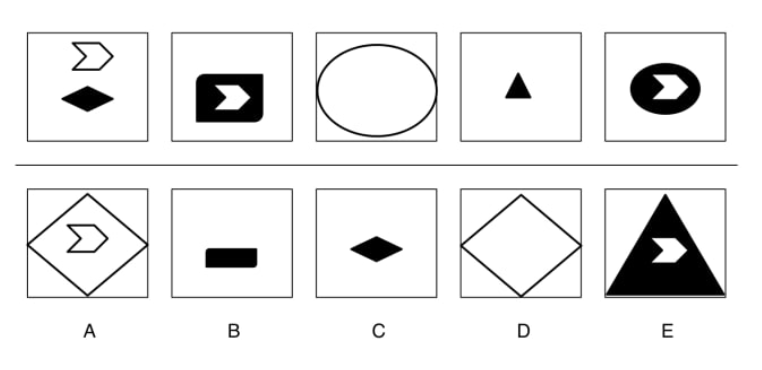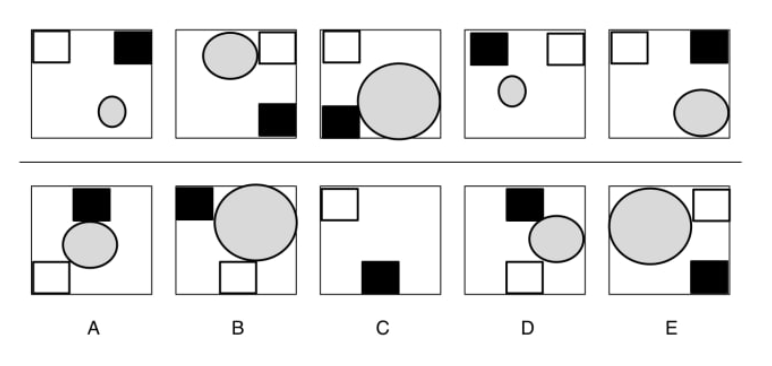The short time limit is frustrating. Speed isn't the only measure of aptitude. A slow, yet correct person should still warrant some points. But with these tight times they get zero.
What Is Diagrammatic Reasoning Test?
A diagrammatic reasoning test, or diagram test, is an assessment that consists of multiple-choice questions based on shapes, patterns, and figures. Diagrammatic tests are scientifically designed to see how adept you are at solving complex problems under pressure.
They do so by asking you to apply both deductive and inductive reasoning. As these skills are inherent to an individual, you’re being tested on your natural abilities, rather than any accumulated knowledge.
In each test, you’ll find a series of different flow charts and/or diagrams, from which you’ll need to deduce sequential rules. You’ll then need to apply these rules to a number of different scenarios to arrive at the right conclusion for each question on the test.
If you’re new to diagrammatic reasoning, you’ll find these tests unlike anything you’ve encountered before. Questions posed are challenging by nature, and you’ll also be working under the pressures of a time constraint.
As such, it’s important to understand exactly what you’ll be facing on the test, and how to prepare accordingly.
How Do Diagrammatic Reasoning Differ to Logical and Abstract Reasoning Tests?
There are various types of psychometric tests that measure your capacity for logic. Diagrammatic reasoning is one, as is abstract reasoning, and whilst the two focus on the same skill set, they take a slightly different approach.
In abstract reasoning tests, candidates are asked to look for relationships across patterns containing shapes and symbols, picking the odd one out or filling in missing parts of a sequence.
Diagrammatic reasoning tests make use of more complex question types, where sequential rules are applied to multiple stages of a process, and used to determine various possible outcomes.
Other tests that fall under the general terms of logical reasoning include critical thinking, inductive, deductive and analytical reasoning. If you’re in any doubt as to the type of test you’ll be taking, contact the employer for clarification.
What Type of Questions Can I Expect on a Diagrammatic Reasoning Test?
Question types on a diagrammatic reasoning test vary according to the test publisher.
The most common type involves diagrams with accompanying keys showing inputs, operators, process and outputs. For each question, part or parts of the diagram will be unknown, and you’ll need to use the rules laid out in the key to draw logical conclusions.
For example, you may see an input to which certain processes have been applied, and be asked to determine the resulting output.
Other question types may include those found in abstract reasoning tests, as well as questions relating to the visual manipulation of shapes. For example, you may be asked to mentally unfold a 3D shape, work out a mirror image, or select the right presentation of an object after a series of rotations.
How Are Diagrammatic Reasoning Tests Formatted?
Again, this can vary between test publishers, but as a general rule, diagrammatic reasoning tests are timed, multiple-choice assessments.
In some cases, your time allowance will cover the test as a whole. In others, you’ll be given a specific number of seconds to answer each question. One minute per question is the average time frame given, and is a good guideline to work to if your test allows you to use your time freely.
You’ll likely find questions will increase in complexity as you progress, so you’ll need to stay focused. One thing you won’t need is any specific knowledge. This is a measure of your natural aptitude, so diagrammatic reasoning tests are universal, not designed around any particular job function.
Why Are Diagrammatic Reasoning Tests Used?
Although the questions on a diagrammatic reasoning test may be unlike anything you’ve seen before, the skills that are being tested are those you’ll use daily in a career in finance.
That’s why employers in the financial sector use them to assist in recruitment. They’re looking for candidates that think logically, and can quickly identify patterns and sequences. These skills are highly valuable in jobs such as accountancy and analysis, and a strong performance on your test shows you have the potential to excel.
They also provide an efficient and objective way of comparing high volume applicants with similar backgrounds, and selecting the most promising talent for interview. This is why they’re so popular in graduate recruitment, and why it’s so important you focus on acing your test to help you stand out from the crowd.
Top Five Tips to Prepare and Pass Your Diagrammatic Reasoning Test
1. Make Practice a Priority
If diagrammatic reasoning is new to you, familiarising yourself with the concept is key. In taking plenty of practice tests, you'll learn the most effective way to approach each question, lessen any test anxieties, and build confidence in your problem-solving abilities.
2. Don't Attempt to Work Backwards
Focus on understanding the logic, rather than trying to fit possible answers into the puzzle. Working backwards is time-consuming, and since the multiple-choice options are often similar, it's easy to slip up if you've not fully explored the governing rules.
3. Manage Your Time
If your test allows you to use your time freely, look at how long you've got against the number of questions, and split your time accordingly. Remember, questions may get progressively harder, so you may want to leave more time towards the end. Taking practice tests under timed conditions will help with your time management.
4. Learn to Spot Distractors
In any given question, there may be elements present that bear no relevance to the underlying logic. These are known as distractors, and are there to add complexity. You need to learn to quickly identify what is pertinent to the problem, and what has been included to distract you.
5. Take an Educated Guess
Most diagrammatic reasoning tests do not apply negative marking, so you won't be penalised for an incorrect answer. Double check that this is the case, and if it is, hedge your bets by taking an educated guess on any questions you're unsure of.
Diagrammatic Reasoning Sample Questions
Q1) Which box comes next in the sequence?
Q2) Which box comes next in the sequence?
Solutions
Q1
Answer = A
Rule 1: The shapes alternate from small, medium to large and repeat.
Rule 2: The small chevron alternates between being present and absent
Q2
Answer = E
Rule 1: The size of the circle changes, small, medium, large and repeats.
Rule 2: The unshaded square alternates between top left corner and right top corner
Rule 3: The shaded square moves one step clockwise around the figure
Jump to a section on this page:
- What Is Diagrammatic Reasoning Test?
- How Do Diagrammatic Reasoning Differ to Logical and Abstract Reasoning Tests?
- What Type of Questions Can I Expect on a Diagrammatic Reasoning Test?
- How Are Diagrammatic Reasoning Tests Formatted?
- Why Are Diagrammatic Reasoning Tests Used?
- Top Five Tips to Prepare and Pass Your Diagrammatic Reasoning Test
- Diagrammatic Reasoning Sample Questions
- Diagrammatic Reasoning Tests Sample Questions
- Diagrammatic Reasoning Tests Tips
- Diagrammatic Reasoning Tests FAQs
Sample Diagrammatic Reasoning Tests question Test your knowledge!
An office manager enforces a policy: If an employee completes a project on time, they receive a bonus. If an employee receives a bonus, they report high job satisfaction. If an employee did not complete a project on time, which of the following must be true?
- They do not receive a bonus
- They receive a bonus
- They report low job satisfaction
- They report high job satisfaction
If all Bloops are Razzies and all Razzies are Lazzies, then all Bloops are definitely Lazzies.
- True
- False
- Cannot be determined
- Only some Bloops are Lazzies
A sequence of logical statements is as follows: If a person is a teacher, then they have a degree; if a person has a degree, they went to college. Which conclusion is valid if the first two statements are true?
- All college graduates are teachers
- Some college graduates are teachers
- No teachers went to college
- Teachers do not have degrees
During a team meeting, four products are pitched, and each product belongs to one of these categories: tech, healthcare, finance, and education. The tech product is introduced before the healthcare product, and the finance product is introduced last. The education product is not introduced first. Which product is introduced second?
- Tech
- Healthcare
- Finance
- Education
From the following statements, select the one that must be true: 1) No Mups are Gups; 2) All Gups are Lups; 3) Some Lups are Mups.
- No Mups are Lups
- All Lups are Mups
- Some Gups are Mups
- Some Lups are not Mups
Well worth the money and highly recommend to every one out there who is not sure they need to practice tests.
Michael used Fintest to help pass his aptitude tests for Amazon.

Diagrammatic Reasoning Tests Tips
- Understand the Basics
Before you dive into practice, familiarize yourself with what diagrammatic reasoning really is. It's all about patterns and processes. Understanding the underlying concepts of these tests will give you a solid foundation. Think of it as learning the rules of a new game before playing it.
- Identify Patterns
Success in diagrammatic reasoning often hinges on your ability to spot patterns. When practicing, focus on how sequences evolve. What changes from one step to the next? Sharpening your pattern identification skills will help you quickly dissect any new set of diagrams you encounter.
- Keep Calm and Reason On
It's easy to get flustered when faced with complex diagrams and tight time constraints. Practice staying calm and composed. If you approach these tests with a clear head and a steady pace, you'll find it simpler to process the information and work through the logic.
- Timed Practice Sessions
The real test will be timed, so your practice should be, too. Use Fintest's practice exams to get used to the pressure of the clock. The more you practice under timed conditions, the more comfortable you'll be when it's showtime.
- Review and Reflect
Don't just plow through practice tests. Take the time after each one to review your answers, especially those you got wrong. Understanding your mistakes is a powerful learning tool and can prevent them from happening when you're sitting down for the real thing.
Level up
Choose the package that works for you.
Pro
- 12 Aptitude packages
- 20 Admissions packages
- 162 Employer packages
- 17 Publisher packages
- Dashboard performance tracking
- Full solutions and explanations
- Tips, tricks, guides and resources
- Access to free tests
- Basic performance tracking
- Full solutions and explanations
- Tips and resources
Diagrammatic Reasoning Tests FAQs
- How are diagrammatic reasoning tests scored?
Generally speaking, you'll receive one mark for every correct answer. The time you took to respond may also be taken into account. Your results will show an overall score, or raw score, as well as a percentile score so you can see how your performance compares to that of other test takers.
- Will I take my test online?
Most employers administer these assessments in the screening stages of recruitment, in which case you'll take your test remotely in a location of your choice. Some may also use them as part of an assessment centre but again these will be computer-based, since pen and paper variations are rarely used these days.
- What do diagrammatic reasoning tests measure?
The tests are primarily designed to measure your logical reasoning skills - i.e. your ability to identify rules and apply those rules to new information. As they are taken under timed conditions, they also measure your ability to apply logic under pressure.
- Do I need to be good at maths for a diagrammatic reasoning test?
There is no mathematical ability required for a diagrammatic reasoning test. You're being measured on your ability to solve problems through logic. Though of course, if applying for a role in the financial sector, mathematical acumen is typically required.
- How do you do well in a diagrammatic reasoning test?
Practice, preparation, and focus are the three key things that will boost your performance. Use our online resources and free practice tests to help you.
Reviews
What our customers say about our Diagrammatic Reasoning Tests
Josh Perry
New Zealand
December 20, 2021
Speed matters most
Akshay Vijay Badithe
United Kingdom
June 27, 2023
It was good but expected more challenging questions
I liked the performance of the interface and creating a timed environment where we can assess ourself. It was also smooth.
Albert Jeremy Manurung
Indonesia
June 27, 2023
Helpful
This website is really helpful to prepare for the test.






